
All musical expressions occur through rhythm. While the spark for musical creativity often originates from an emotional and spiritual place, rhythms are governed by mathematical values.
The building blocks of music, including note and rest values, chords, intervals, scales, time signatures, counting, downbeats and upbeats, form and tempo are all based on math. While developing “good rhythm” ultimately comes down to feel, groove and inspiration, an understanding of the arithmetical nature of music has the potential to help improve your skills, increase the number of musical choices at your disposal, and enhance your overall performance.
Based on its raw simplicity, the acoustic guitar, which songwriters have long drawn upon in the evolution of crafting pop songs, provides the ideal starting point in the journey toward developing a solid sense of rhythm. Players like Django Reinhardt, Al Di Meola, Paco de Lucia and John Mclaughlin come to mind as true masters of rhythmic precision in their execution of brilliant acoustic lead runs.
The vitality of Neil Young’s strummed guitar chords and the elegance of Andrés Segovia’s classical lines collectively reveal the multifaceted expressions and diverse rhythmic possibilities offered by the acoustic guitar. Equally impressive is the playing of the great Delta Blues musicians like Robert Johnson and Sonny Boy Nelson, whose use of silence, or “space,” between responsive expressions continues to strike a chord in our souls. In the 21st century, the latest evolution in popular guitar performance can be attributed to the “percussive acoustic” genre.
Antoine Dufour and Andy McKee’s steady sense of time while creating interplay between harmony and percussion in the absence of drums creates moments of intensity, sentimentality and reflection. The instrument’s organic, honest nature can leave a guitarist’s every strum and subtle motion exposed, and so mastering rhythm will strengthen your ability to perform in all musical contexts. In this lesson, we offer 20 ways to cultivate solid rhythm playing skills on the acoustic guitar.
1. Start with a Single Note and Chord
Improve your playing by varying rhythmic values on a single note or chord. Go for precision and move from a whole note to half notes, quarter notes, eighth notes and 16th notes and back, then apply the same process with a single chord, as demonstrated in FIGURES 1 and 2. From these focused drills you can learn many things that apply to all aspects of your playing.
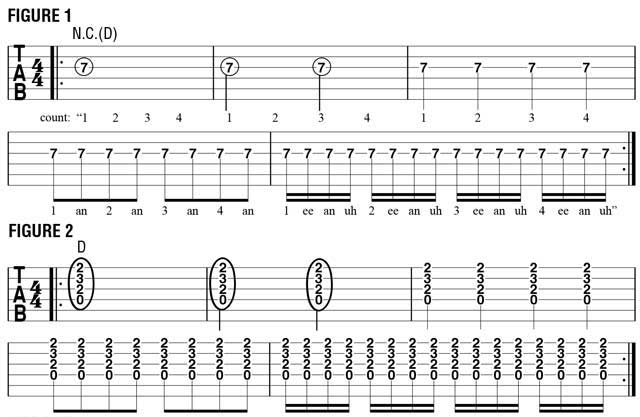
2. Clap and Play
Sightreading music can be quite demanding on the brain and challenging. It’s often very helpful to first figure out and internalize the rhythms, by just clapping them, before attempting to recognize and play the notes, as illustrated in FIGURE 3. Clapping the line first helps you establish what its rhythmic phrasing is, without the distraction of having to think about the notes and where you’re going to play them on the fretboard.
Once you establish the rhythm in this way, the part becomes a little less daunting to sightread and easier for your brain to process, as you’ve already won half the musical battle. This is an especially useful step to go through whenever you’re required to sightread at a gig or recording session, as you can silently “rehearse” the part in your head, by quietly tapping out the rhythms with a single finger and tapping your foot on each downbeat while waiting for your cue to begin playing.
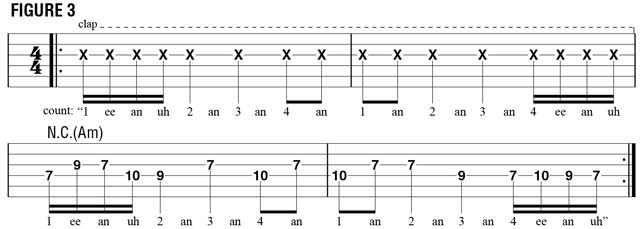
3. Know Your Meter
All beats are not created equal within a measure, or bar. Understanding which beats get more emphasis than others is fundamental to generating feel and groove. Traditionally, in 4/4 time (meter), beat one receives the most pronounced accent, or emphasis, beat two is considered “weak” (soft), beat three receives a medium-heavy accent, and beat four is weak.
In 3/4 time, beat one receives a heavy accent, followed by weak beats on two and three. In 2/2, beats one and two both get heavy accents, and in 6/8 meter, beats one and four are accented.
FIGURE 4 illustrates all four of these meters and their natural accent patterns with a strummed Am chord. These are, of course, just basic guidelines, and the “rules” are broken all the time in the real world of music! For example, in rock, r&b, blues, jazz, funk and other styles, beats two and four, in 4/4 meter, typically receive the accent, as exemplified by a drummer hitting the snare drum on these beats, which creates what’s called a “backbeat.”

4. Play in a Variety of Time Signatures
The time signature—that fractional number you see at the beginning of a piece of sheet music—determines the meter and pulse of the song, meaning how many beats there are in each bar and which ones receive the natural emphasis, as described in the examples above. It’s important and good for your musicianship to learn how to play in and feel musical grooves in a variety of meters, not just 4/4. FIGURES 5–8 present four different rhythmic and metric incarnations of the same basic musical idea, each offering a different groove and feel.
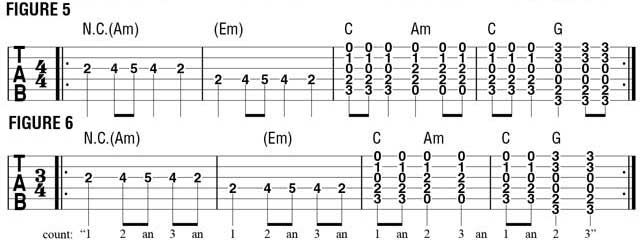
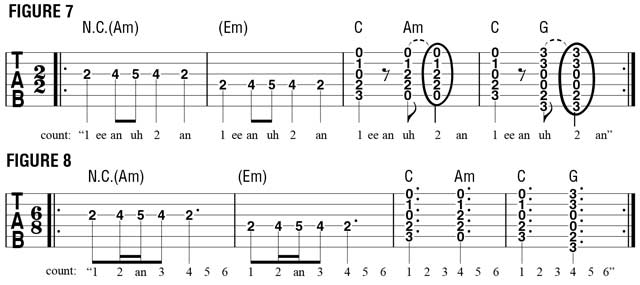
5. Odd Meters
As its name implies, an odd time signature indicates an odd meter, meaning one with an uneven number of beats per bar, such as 5 or 7. The most commonly used odd meters are 5/4, 7/8 and 11/8. In 5/4, the accents are typically felt on beats one and four (see FIGURE 9), and in 7/8, beats one, three and five are usually accented (see FIGURE 10). The typical accents for 11/8 are on beats one, three, five, seven and nine (see FIGURE 11).
Examples of well-known songs in odd meters include Radiohead’s “15 Step” and Dave Brubeck’s “Take Five” (both in 5/4), Peter Gabriel’s “Solsbury Hill,” Genesis’ “Turn It On” and Pink Floyd’s “Money” (all in 7/4) and the intro riff to the Allman Brothers’ “Whipping Post” (11/8).
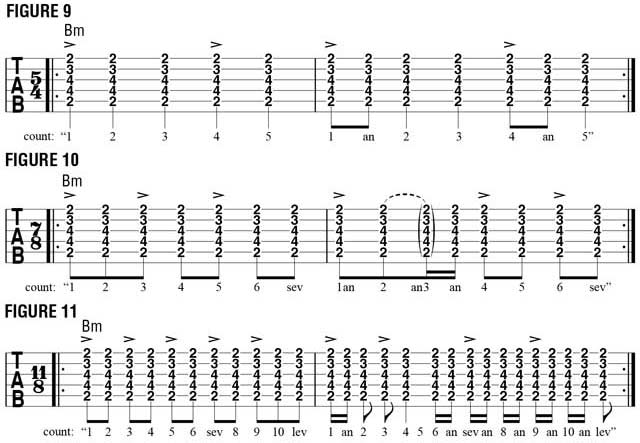
6. Change Tempo
Most music that follows a pulse, meaning that it’s played “in time,” is performed at a certain rate, or speed, known as tempo, generally, slow, medium or fast. When learning a song, try practicing it at its normal, intended tempo, and also twice as fast, then at half tempo. In so doing, you’ll expose every rhythmic and technical movement on the guitar, revealing both the fluid parts and areas that require attention and work. Try doing this with FIGURE 12.

7. Syncopate and Anticipate
Syncopated rhythms feature irregular accents falling on parts of the beat or bar that are not naturally emphasized in a given meter. As such, they can be used to provide interesting variety in rhythmic phrasing, as well as generate intensity and produce unexpected rhythmic-melodic contours.
Play the straightforward G-to-Am chord change in the first bar of FIGURE 13, then notice how its feel is transformed in bar 2 by anticipating the Am chord—changing to it a half beat “early,” on the “and” of beat two. Notice the sense of urgency and “push” created by syncopating the harmonic rhythm (the rhythm of the chord changes) in this way.

8. Learn Unfamiliar Styles
A great way to expand your rhythmic vocabulary is to learn a variety of world music rhythms that are emblematic of a particular genre. Jeff Beck’s “Beck’s Bolero” comes to mind as a song that’s built around a bolero rhythm, a repeating two-bar pattern that begins with a quarter note on beat one, an eighth-triplet on beat two, a quarter note on beat three, followed again by triplet on beat four. In the second bar, a quarter note on beat one is followed by three beats of triplets, on beats two through four.
Similarly, learning the signature rhythms of musical styles from places like Western Africa (FIGURE 14), Bulgaria (FIGURE 15) and Thailand (FIGURE 16) will expand your rhythmic vocabulary.
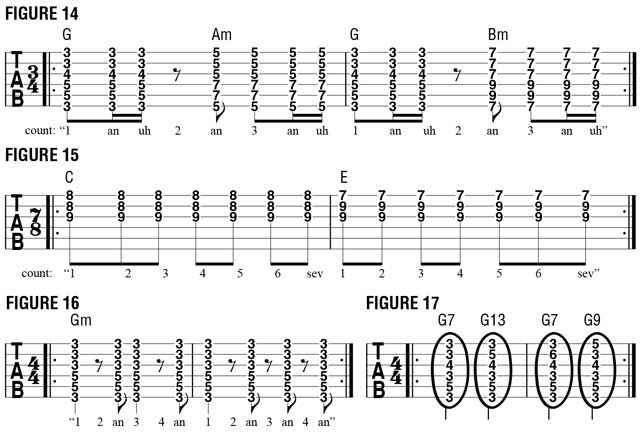
9. Focus on Sustain
In order to get the most out of the chords you play, consider how long the notes ring, using a variety of different rhythms and durations. Forming chords that require all your fretting fingers and a full barre, like those in FIGURE 17 (above), allows you to focus on the sustain of each note, which will help ensure that all notes in your chords are held for the appropriate, intended duration, creating a fuller tone.
10. Play for the Context
The way rhythm guitar parts are performed can and should change somewhat, depending on the musical context and setting. For example, oftentimes you may be asked to condense what was previously a full band arrangement into a solo guitar performance or an “unplugged” accompaniment behind a vocalist, for which you’ll want to fill out the part rhythmically, to compensate for the lack of a rhythm section backing you up.
FIGURE 18 moves in the opposite direction, transitioning from a rhythmically “busy” solo guitar arpeggiation figure to a slightly “airier” solo-guitar accompaniment to a rhythmically sparse series of ringing half-note chord strums, which might work best in a full band arrangement, with drums filling out the groove. Know your role and play for the arrangement and setting.

11. Focus on Picking Direction
Pick stroke direction matters. Learning how to alternate pick or strum—meaning “down-up-down-up”—is essential in order to bolster your note and chord articulation options, cultivate technical accuracy and achieve rhythmic fluidity. Playing on the lower three strings, due of their greater thickness, requires extra attention to good picking form in order to clearly articulate and differentiate each note. Go for precision!
FIGURE 19 is an exercise in alternate picking single notes, and FIGURES 20 and 21 have you playing, respectively, reggae- and ska-style chord parts, in both cases using consecutive upstroke strums.
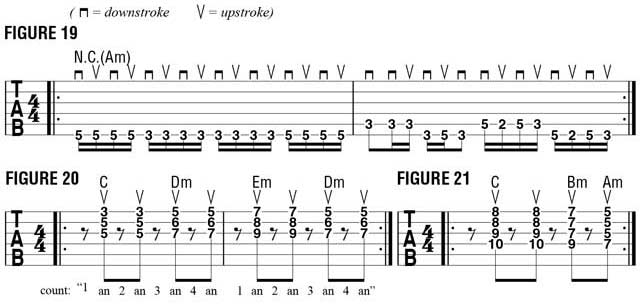
12. Displace Accents
One of the most effective ways to improve your rhythmic skills is to experiment with varying accents. Perform a passage “normally,” then play it again with accents moved to different places, creating syncopation without changing the notes you’re playing.
FIGURE 22 is a basic example of this approach that has you staying on a Bb note, using quarter-note, eighth-note and 16th-note rhythms, and, in the second bar, varying the accents with your pick strokes. (Hit the accented notes harder than normal.) FIGURE 23 has you doing a similar thing with a repeating single-note melody in 3/4 meter.
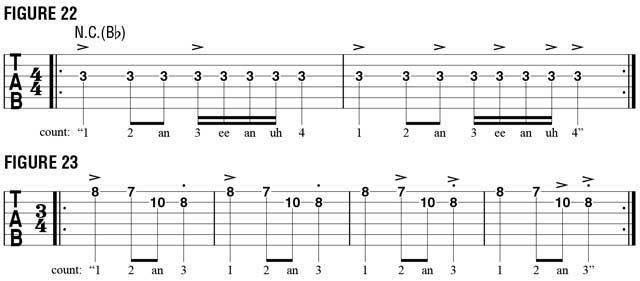
13. Focus on Tone and Texture
Your tone is affected in part by the rhythms you play. This is determined not only by where on the strings you choose to fret and pick each note or chord, but also by the density and thickness of the chord voicings and the duration you give them, meaning how long you let the notes ring before damping, or muting, them with either hand. The fullness of your sound is determined by the richness of the chords.
Play the four-chord progression in FIGURE 24 as written, then see how many different ways you can vary it, by using different rhythms and voicings of the same basic chords.

14. Play Polyrhythms
A polyrhythm occurs when two or more different, independent rhythms are performed simultaneously while working collectively as a whole, in relation to a synchronizing downbeat. Polyrhythms are a signature element of West and West-Central African djembe circles and Soukous music, where each part or instrument in an ensemble has its own unique rhythm.
With a solo guitar, polyrhythms can be realized by thinking in terms of separate string groups and playing two or more different rhythms on them. Divide a single chord into sections and assign a rhythm to each string group.
FIGURES 25 (above) and 26 (below) have you integrating a bass part on the lower strings with notes played on the higher strings. Once you get the hang of playing these examples, try applying these approaches to chord progressions.
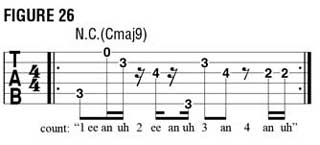
15. Transcribe
A great way to learn new rhythms and develop rhythmic sensibility and awareness is to listen to songs and transcribe various parts using rhythmic notation, either with notes or tablature. Don’t limit yourself to only guitar parts either. You can also transcribe piano, bass, vocal and drum rhythms. My final assignment in music school was to transcribe all of the piano parts played by Wynton Kelly on the classic Miles Davis jazz recording “All Blues” and perform them on guitar. That was a tremendously challenging and ear-opening experience!
16. Use Different String Groups
Another good way to improve your rhythmic fluidity and facility is to apply various rhythms to full barre chords, triads and diads (two-note voicings) and practice alternating between different string groups. FIGURES 27–29 have you strumming different voicings of a C chord, and in FIGURE 30 we’re playing a four-chord progression on varying string groups.
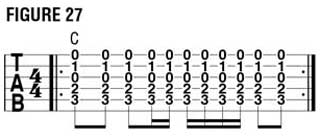
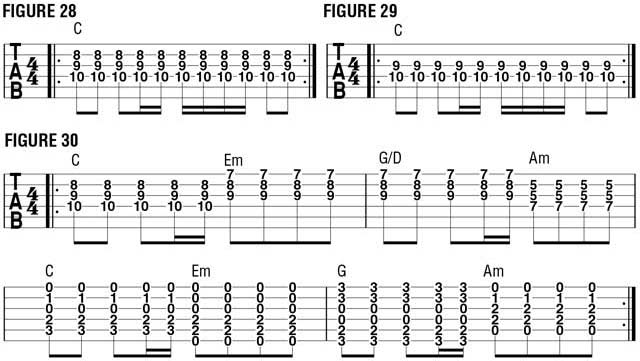
17. Layer Rhythms with a Looper
Try layering various rhythms sequentially, using a digital looper pedal. Doing this in a live performance adds a sense of spontaneity and requires rhythmic sensibility and precision, as well as creativity and tasteful restraint. As a starting point, try layering the parts illustrated in FIGURES 31–34, then come up with your own rhythmic-harmonic-melodic “layer cakes,” starting out simple and getting more complex and sophisticated as you go.
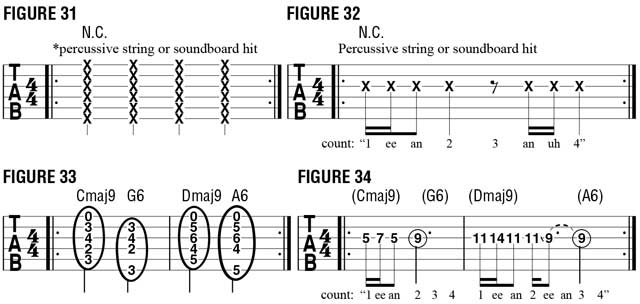
18. Explore Percussive Playing
Solo guitarists who play in a percussive style depend on rhythmic variety, precision and a strong sense of time in order to create exciting, captivating grooves in the absence of drums. Percussion is not limited to hitting just the body of the guitar but also the strings over the sound hole and fretboard, using either or both hands.
FIGURE 35 is a basic example of alternating between chord strums and percussive hits on either the strings or soundboard, and FIGURE 36 interweaves percussive hits with open strings and hammered-on chords with a triplet feel. See how many variations you can come up with on these basic repeating patterns!
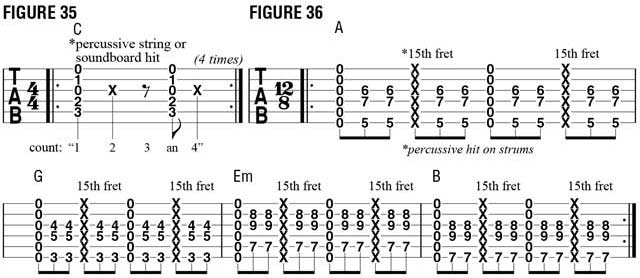
19. Use Silence
Rhythm is governed as much by silence as it is by sound, and great musicians like B.B. King and Miles Davis were masters of the art of using space in their playing in order to create suspense, excitement and soulful solos. FIGURES 37 and 38 offer examples of using rests to create big “holes of silence” within a chord part and a melodic lead, respectively.
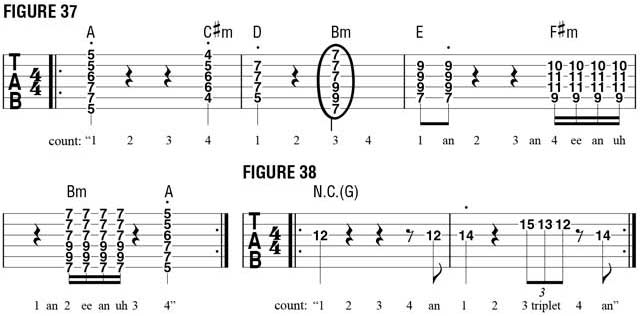
20. Just Jam!
Probably the best way to develop your rhythmic intuition is to simply jam with other musicians. While there is no substitute for this kind of live interaction, playing along with recordings is the next best thing. Try playing along with unfamiliar songs in a variety of musical genres and learn as many rhythms as possible, from Brazilian Bossa Nova chords strummed by Joao Gilberto to African guitarists Habib Koite and Oliver Mtukudzi. Lastly, use a metronome when practicing. This will help you hone your rhythmic precision and sense of time.Jeff Gunn (jeffgunn.ca) is author of the series Hidden Sounds: Discover Your Own Method on Guitar, guitarist/musical director for Emmanuel Jal and composer of All the Roads We Take (2017).
Get The Pick Newsletter
All the latest guitar news, interviews, lessons, reviews, deals and more, direct to your inbox!








![Joe Bonamassa [left] wears a deep blue suit and polka-dotted shirt and plays his green refin Strat; the late Irish blues legend Rory Gallagher [right] screams and inflicts some punishment on his heavily worn number one Stratocaster.](https://cdn.mos.cms.futurecdn.net/cw28h7UBcTVfTLs7p7eiLe.jpg)

